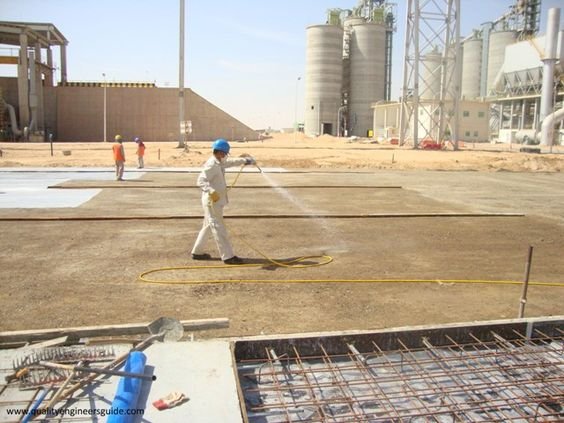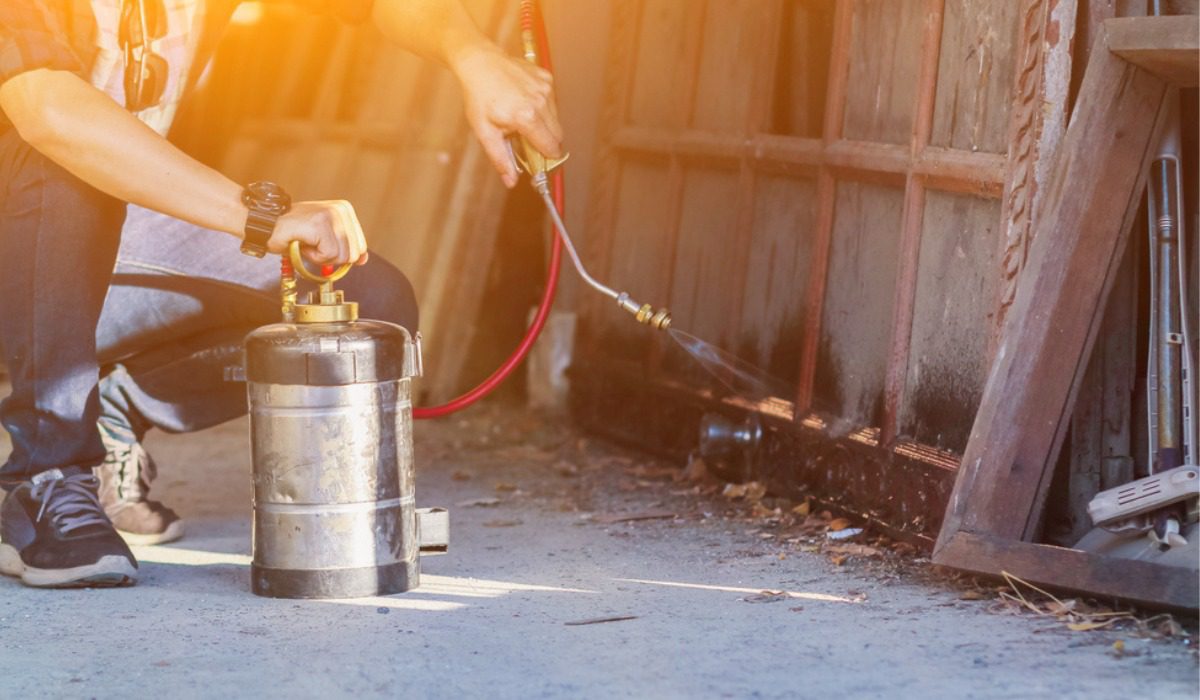An anti-termite treatment is a pre-and post-construction chemical process that protects a structure against subterranean termites by treating the soil, masonry, wood, and electrical fixtures. In this article, we’ll talk about anti-termite chemicals, pre- and post-construction treatment, preventative methods, safety, and common products used for home treatment.
Anti-termite treatment: What does it mean?

Source: Pinterest
Anti-termite treatment is a chemical treatment performed on ground, brickwork, wood, and electrical fixtures before and after construction to offer a chemical barrier against subterranean termites. For the most part, subterranean termite treatment is accomplished by the use of liquid pesticide sprays that are injected or drenched into the soil.
Anti-termite treatment: Importance
- Controlling the population of termites in buildings is essential because the structural damage caused by termites can be extensive.
- Damage to non-cellulosic materials is another well-documented consequence of termites’ foraging behaviour.
- Termites chew through neoprene, plastic, rubber, leather, and the lead coating used to protect subterranean wires.
Anti-termite treatment: Pre-construction

Source: Pinterest
The following describes the steps to take to treat a building for termites before construction.
- To prevent termites from colonising in the future, it is standard practice to apply an anti-termite chemical to the sides and bottom surface of the foundation trenches and pits at a rate of 5 L per square metre of the surface area during the excavation process.
- Before it can be used as flooring, the earth’s surface must first be cleared of any debris made of wood or other waste.
- The needed height should be applied evenly throughout the whole surface. The distance between each surface hole is 15 centimetres, and it has a depth of 30 centimetres.
- Adding water to the chemical will result in the production of an emulsion that has the appropriate concentration (as specified in the manufacturer’s specification).
- The holes will have this emulsion poured into them using pouring jars, and the surface will be sprayed with it using pressure pumps and sprayers.
- It is permitted for the chemical to completely soak through the perforations in the screen.
- Note that the anti-termite treatment for termite-prone regions must be carried out by a specialist organisation that has been reviewed and authorised.
Anti-termite treatment: Advantages of performing pre-construction termite inspections and treatments
Economic
As opposed to post-construction solutions, pre-construction treatment involves fewer processes since it is done before the building is constructed. Therefore, the price of the termite treatment is reduced.
Fewer hurdles
In the event of anti-termite treatment performed before construction, there are fewer obstacles to overcome. Walls and other major construction components provide unrestricted movement across a structure, allowing occupants to reach every nook and cranny of the structure with ease.
Eliminate infestation at source
It could be too late to cure your house, building, or structure for termites after it has been built since termites may have already begun eating away at the foundation, walls, or wooden attachments in your home before you decide to have post-construction anti-termite treatment. It is suggested to treat the area before building to destroy the termite infestation at its source.
Anti-termite treatment: Post-construction
Inspection
Before any kind of treatment is carried out, a comprehensive assessment of the infestation in the building has to be carried out. The goal of this inspection is to determine the amount to which the infestation has spread, as well as the access points that termites use to get into the structure.
Elimination of termites in the structure
The location of the termites can be determined by an investigation of the infestation. The termites must be hunted down and eradicated in all of their hiding places inside the structure, which may include the ceilings behind wooden panellings, the interior of electrical wiring battens, conduits, switchboards, and other areas. The extermination process must be carried out thoroughly.
see also: Water treatment techniques in detail
Anti-termite treatment: Preventative steps and precautions
- The main goal of treating the soil is to create a chemical barrier between the termites in the soil and the structure that is to be protected against termite infestation.
- To treat the soil outside of the foundations, the soil that is in touch with the exterior wall of the building must be treated with chemical emulsion at the rate of 7.5 L/Sqm. This treatment must go to a depth of at least 300 mm.
- The termites look for openings or cracks in the following areas to crawl through to get into the building:
- As a consequence of the concrete’s shrinking, there is a gap at the intersection of the floor and the walls.
- As a result of structural flaws, cracks appeared on the surface of the floor.
- In a concrete floor’s construction joints and expansion joints, respectively.
- Whenever cracks are seen on the bottom level of a structure, chemical treatment should be used. To achieve this, 300 mm intervals are drilled at the floor/wall junction, construction joints, and expansion joints (all of which were stated before) to drill 12 mm holes vertically down to the earth.
- The wood is treated only where it comes into touch with other materials. Anti termite treatment must be applied in all areas where the wood in the structure comes into contact with other wood.
- Drilling 6mm holes at a downward angle of approximately 45° at the intersection of woodwork and masonry allow the chemical emulsion of concentration to be sprayed directly at the places of contact with the adjacent masonry.
- Wall switch boxes and other electrical outlets can be treated by removing their protective covers and dusting them on the inside with a Malathion formulation at a concentration of 5%.
Anti-termite treatment: On woodwork
Woodwork can be broken down into the following categories for the purposes of treatment:
- It has suffered irreparable damage at the hands of termites and must be replaced.
- Termites have done irreparable damage to the wood. Thus, they must be replaced.
- Before using fresh wood, it needs to be chemically treated by being soaked at least twice in a mixture of kerosene and mineral oil.
- The following procedures are to be carried out on any damaged woodwork that does not need replacement: Woodwork in the purlins, frame, joints, etc., that is infested and is in touch with either the walls or the flooring. They are to be given a protective function by having holes around 3 millimetres in diameter drilled into them at an angle that slopes downward toward the centre of the woodwork. These holes should have a centre-to-centre distance of at least 150 millimetres and should span the whole of the structure.
- If the wood is not protected by varnishing and painting, then two coats of the chemical must be applied to all surfaces that are next to the masonry.
Anti-termite treatment: On electrical fixtures
- If there is evidence of infestation in an electrical fixture, such as a switch box, a panel, or the wiring in the wall, the covers of the switch boxes must be removed, and the inside of the boxes must be inspected.
- It is recommended that a dusting powder containing 5% malathion or chlorpyrifos be generously applied to them. Following the application of the powder, the switchboards should be readjusted.
Anti-termite treatment: Mistakes to avoid

Source: Pinterest
- For the treatment to be successful, the specified amount of pesticide should be applied to each individual section of the treated area.
- Under the whole of the building that has to be protected, the barrier should be comprehensive and unbroken.
- Every foundation should be completely encircled by the barrier or treated soil, and it should be in close contact with the foundation.
- No staff must be allowed to access the plots while the treatment is being carried out.
- Do not store or keep pesticides in containers that are not being used.
Anti-termite treatment: Tips to protect furniture from termites
- Make sure that none of your furnishings is in contact with any kind of moisture.
- It is recommended that you sometimes apply aloe vera gel to your hardwood furniture since this acts as a protective layer.
- Invest in a wood polish and hire a specialist to apply it to each and every piece of wooden furniture in your home.
- It is important to get rid of any wooden items you no longer require from your house since they might serve as a bug breeding habitat.
- If a person lives in a coastal city, they should have periodic chemical treatments administered by trained professionals.
You will no longer have to worry about termites digging into and destroying your wooden furniture if you follow these guidelines on how to get rid of termites in your house.
Anti-termite treatment: At home

Source: Pinterest
Until a professional exterminator comes in and gives the necessary treatment to totally get rid of termites and prevent any future infestations, home remedies can aid in decreasing the spread of termites and stopping further infestation. The following is a list of the termite treatments that are most often used at home.
Neem oil
The leaves and seeds of the Neem tree are used to make an oil with powerful therapeutic qualities known as neem oil. There have been studies showing that termite reproduction can be disrupted by neem oil. If a termite consumes the oil, it will undergo a hormonal shift. Because of hormonal disruption, the termite loses track of time and fails to feed or mate. Termite reproduction, including egg laying, is halted as a result.
White vinegar
Another traditional domestic remedy for termites is white vinegar. To make the most effective vinegar combination, add a few teaspoons of fresh lemon juice to half a cup of vinegar. Every day, spray the mixture twice or three times to keep termites at bay. Vinegar is not as efficient as other disinfectants, however.
Boric acid
Boric acid, often known as sodium borate, is a popular cleaner used in many homes. Boric acid kills termites by attacking their nervous systems, which causes them to shut down and dehydrate. A termite infestation can be treated by applying a thick layer of boric acid powder to the affected regions. Another option is to combine boric acid with hot water and spray it on the affected regions every day. The spray is effective against both dry wood and subterranean termites.
Salt
The use of salt, or sodium chloride, in combating and avoiding termite infestations has been documented. To fill syringes with a salt solution, you must first dissolve the salt in hot water. Put the syringe to use at the colony’s main gate. Cotton balls soaked in the mixture can be put close to the infestation, or the liquid can be sprayed on the diseased region.
Diatomaceous earth
To prevent termites, many people turn to diatomaceous earth. Diatomaceous Earth is so abrasive that it may penetrate the termites’ protective chitin coating. The termites die of dehydration as a result. However, diatomaceous earth is toxic to people and may harm the lungs; thus, a mask must be worn at all times while applying the substance. To kill termites and reduce an infestation, sprinkle a little coating of Diatomaceous Earth over the affected areas every day. To keep pests at bay in the future, you can also sprinkle them around the house’s base.
Orange oil
Due to its low toxicity, orange oil is a perfect choice for eliminating termites. D-limonene, found in orange rinds, is non-toxic to people and pets yet effective against termites. It is best to use orange oil on a pest problem when it is first noticed before the problem has had time to develop and spread. Orange oil is applied topically to the affected area(s) several times before any apparent improvement is seen.
Anti-termite treatment: Benefits
- Any construction receives rapid protection against termites, rats, and other pests thanks to this feature.
- It has been effective for many years.
- It solves the issue of cracks appearing in the protective barrier, which would otherwise enable termites to get into the house.
- When compared to other methods of termite management, the cost of liquid termiticides is on the lower end of the spectrum.
FAQs
What chemical is used to eliminate termites?
To make the required solution, one litre of 20% Chlorpyrifos EC must be combined with 19 litres of water.
What naturally eliminates termites?
Boric acid is a natural insecticide that is often available as a powder. You may either sprinkle it on the infested area or combine it with water to spray it. One should use goggles, masks, and gloves while spraying the acid.
Is termite treatment dangerous for humans?
To some degree, all chemicals used for pest control are harmful. Nevertheless, they are not harmful to humans, at least not in the quantities employed in pest management.
What causes termite infestations?
The soil-dwelling termites that are drawn to moisture are subterranean. The presence of standing water in or near the foundation of your house attracts termites.
What kind of climate do termites inhabit?
Termites enjoy warm, humid temperatures and are thus most prevalent in areas with a subtropical climate.
Housing News Desk is the news desk of leading online real estate portal, Housing.com. Housing News Desk focuses on a variety of topics such as real estate laws, taxes, current news, property trends, home loans, rentals, décor, green homes, home improvement, etc. The main objective of the news desk, is to cover the real estate sector from the perspective of providing information that is useful to the end-user.
Facebook: https://www.facebook.com/housing.com/
Twitter: https://twitter.com/Housing
Email: [email protected]











